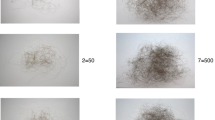Abstract
Prevalence and risk factors of androgenetic alopecia (AGA) in policemen are not known. This study aimed to compare the prevalence and risk factors of AGA between policemen and the general population. A cross-sectional survey was conducted by recruiting a total of 758 (78%) of 972 policemen and 740 (80%) of 924 participants in a community-based integrated screening served as a comparison group. The Norwood classification system was used to assess the degree of hair loss. Information on age, family history of androgenetic alopecia, and other possible risk factors was collected with questionnaire interviews. The association analysis between policemen and the general population was limited to participants aged 40–59 years. After controlling for other significant factors, policemen aged 40–59 years had an increased risk of developing AGA compared with the general population (OR = 2.23, 95% CI 1.14, 4.36, p = 0.02). Obesity measured by waist circumference and body mass index made contribution to higher risk for AGA in younger policemen (20–39 years). A statistically significant association was noted between AGA and sunlight exposure in policemen aged 40–59 years. We concluded the prevalence of AGA in policemen was twofold higher than that in the general population. Obesity at young age and sunlight exposure may be responsible for higher risk of AGA in policemen. However, further studies are warranted to confirm the current findings.

Similar content being viewed by others
References
Arias-Santiago S, Gutierrez-Salmeron MT, Buedia-Eisman A, Giron-Prieto MS, Naranjo-Sintes R (2010) A comparative study of dyslidaemia in men and women with androgenetic alopecia. Acta Derm Venereol 90:485–487
Arias-Santiago S, Gutierrez-Salmerón MT, Buendia-Eisman A, Giron-Prieto MS, Naranjo-Sintes R (2011) Sex hormone-binding globulin and risk of hyperglycemia in patients with androgenetic alopecia. J Am Acad Dermatol April 19. [Epub ahead of print]
Arias-Santiago S, Gutierrez-Salmeron MT, Castellote-Caballero L, Buedia-Eisman A, Naranjo-Sintes R (2010) Androgenetic alopecia and cardiovascular risk factors in men and women: a comparative study. J Am Acad Dermatol 63:420–429
Arias-Santiago S, Gutiérrez-Salmerón MT, Castellote-Caballero L, Naranjo-Sintes R (2009) Elevated aldosterone levels in patients with androgenetic alopecia. Br J Dermatol 161:1196–1198
Batrinos ML, Panitsa-Faflia C, Koutsoumanis C, Vourlioti T, Koutsilieris M (1999) Surgical stress induces a marked and sustained increase of adrenal androgen secretion in postmenopausal women. In Vivo 13:147–150
Chen TH, Chiu YH, Luh DL, Yen MF, Wu HM, Chen LS, Tung TH, Huang CC, Chan CC, Shiu MN, Yeh YP, Liou HH, Liao CS, Lai HC, Chiang CP, Peng HL, Tseng CD, Yen MS, Hsu WC, Chen CH, Taiwan Community-Based Integrated Screening Group (2004) Community-based multiple screening model: design, implementation, and analysis of 42, 387 participants. Cancer 100:1734–1743
Johnsson A, Kjeldstad B, Melo TB (1987) Fluorescence from pilosebaceous follicles. Arch Dermatol Res 279:190–193
Kupper TS, Groyes RW (1995) The interleukin-1 axis and cutaneous inflammation. J Invest Dermatol 105:62–66
Ludwig E (1977) Classification of the types of androgenetic alopecia (common baldness) occurring in the female sex. Br J Dermatol 97:247–254
Matilainen V, Koskela P, Keinanen-Kiukaanniemi S (2000) Early androgenetic alopecia as a marker of insulin resistance. Lancet 356:1165–1166
Marmar CR, McCaslin SE, Metzler TJ, Best S, Weiss DS, Fagan J, Liberman A, Pole N, Otte C, Yehuda R, Mohr D, Neylan T (2006) Predictors of posttraumatic stress in police and other first responders. Ann N Y Acad Sci 1071:1–18
Norwood OT (1975) Male pattern baldness: classification and incidence. South Med J 68:1359–1365
Stuart H (2008) Suicidality among police. Curr Opin Psychiatry 21:505–509
Su LH, Chen TH (2007) Association of androgenetic alopecia with smoking and its prevalence among Asian men. Arch Dermatol 143:1401–1406
Su LH, Chen THH (2010) Association of androgenetic alopecia with metabolic syndrome in men: a community-based survey. Br J Dermatol 163:371–377
Trueb RM (2002) Molecular mechanisms of androgenetic alopecia. Exp Gerontol 37:981–990
Trueb RM (2003) Is androgenetic alopecia a photoaggravated dermatosis? Dermatology 207:343–348
Author information
Authors and Affiliations
Corresponding author
Additional information
KCIS: Keelung Community-based Integrated Screening.
Rights and permissions
About this article
Cite this article
Su, LH., Chen, HH. Androgenetic alopecia in policemen: higher prevalence and different risk factors relative to the general population (KCIS no. 23). Arch Dermatol Res 303, 753–761 (2011). https://doi.org/10.1007/s00403-011-1173-5
Received:
Revised:
Accepted:
Published:
Issue Date:
DOI: https://doi.org/10.1007/s00403-011-1173-5




